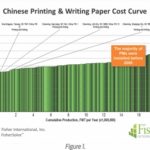The European paper industry recently launched the reviewed version of its 2050 Roadmap detailing the pathways and investment needed to cut its carbon emissions by 80 percent while creating 50 percent more added-value. The Roadmap projects the need for EUR 44 billion more investment – a 40 percent increase on current levels – to transform industry in Europe and lead the low-carbon bioeconomy by 2050.
Leading the debate under unfolding the future since 2011, CEPI has been at the forefront of a movement intending to create a low-carbon bioeconomy in the European forest fiber and paper industry. Its pioneering publication Forest Fiber Industry: 2050 Roadmap to Low Carbon Bio-Economy in 2011 initiated the debate in broad-based manner as to how to realize the vision of a low-carbon and value-creating industry transformation. This roadmap attempted to lay out the future of the forest fiber industry and its potential to meet future consumer demands, stay competitive and deliver a CO2 emission reduction. In 2011’s roadmap, the industry launched the perspective of decarbonising by 80 percent, while creating 50 percent more added value by 2050. In a fast-changing and competitive regulatory environment, CEPI’s reviewed version of the roadmap reaffirms its ambition and belief that such industrial transformation can be “made in Europe” with the right pro-investment policies and financing conditions in place.
Leading the Way to a Climate-friendly Bio-economy
CEPI has persistently explored ways for the industry to reduce its emissions and add value to its materials, products and processes. Significant progress has been made over the past five years on research and innovation as well as on investments. The industry has already reduced its total (direct and indirect) greenhouse gas emissions by 44 percent per tonne of product since 1990.
The revised Roadmap focuses on investments. It also underscores how an unprecedented industry transformation could be “made in Europe” provided that R&D, policies and financing conditions are aligned. The trends which underlined CEPI’s Roadmap six years ago are valid even today and have been duly incorporated while formulating or strategizing the new Roadmap. These trends include Europe’s ageing demography; Europe’s low-growth rates and shrinking share of global GDP; maturing of Europe’s markets for existing products with the bulk of global demand occurring outside Europe; societal demands for sustainable and responsible products remaining strong, next to high-value and high-quality products, e.g. traceability, resource efficiency, recycling, etc.; and new green jobs and technologies require reformed education and skills systems.
In addition, CEPI’s Roadmap takes into account the acceleration in digitization of manufacturing – the so-called Industry 4.0, the evolution of consumer behavior (connectivity, the collaborative economy, and mass-customization), and the Paris Agreement to limit climate change resulting in increasing global pressure to reduce carbon emissions. The Roadmap emphasizes the adequate investments in manufacturing and designing of policy framework to usher in the direction of achieving the targets set.
The document talks how several EU policies – both implemented and under development – are already shaping the sector’s investment capabilities and decisions. The most prominent of these being the 2030 Climate and Energy Framework with new targets for emission reductions, renewable energy and energy efficiency and the related Emission Trading System (ETS); the 2012 Bioeconomy Strategy that aims at ensuring fossil materials are replaced with sustainable and renewable alternatives; the future of the EU framework programme for research Horizon 2020, including the Bio-based Industries Public Private Partnership; the Circular Economy Package, which would enhance recycling capabilities and offer more opportunities for bio-based products; and the European Fund for Strategic Investments (EFSI), which, beyond its focus on infrastructure, may offer new funding opportunities for transformative investment.
Creating 50 Percent More Added Value: Leading the European Bioeconomy
With its ambition to add 50 percent more value compared to 2010, the European forest fiber industry would deliver approximately EUR 25 billion added value in Europe by 2050 (gross value added at factor cost). This development should partially result from efficiency gains, enabled by smarter manufacturing, better data management and the Industry 4.0 revolution.
Adding new functions and services to existing paper and board products – connectivity, anti-counterfeiting, water-repellence, etc. – can also offer new ways to differentiate European production from global competition, with higher value and tailor-made solutions.
Together with the growth of existing product segments, such as packaging, hygiene or specialty papers, these developments would generate EUR 5 billion of added value. The projected evolution of industry’s product segments also shows that another significant share of added value (+ EUR 3.5 billion from 2010) will come from the development and growth of new bio-based products.
Ranging from food additives to biocomposites, from advanced biofuels to nanocellulose, these emerging bio-based products will indeed bring even more opportunities for growth from renewable and innovative solutions to move away from a fossil-based economy.
Decarbonising by 80 Percent: Moving Away from a Fossil-based Society
Quantitatively, decarbonising by 80 percent compared to 1990 means that the European forest fiber and paper industry emissions would be brought down to 12 million tonnes of CO2 by 2050. This absolute emission reduction would not account for the benefits provided by carbon sequestration in managed forests, its long-lasting storage in bio-based products that are further recycled, or the substitution of fossil-based and less climate-friendly products and materials. Nevertheless, reducing the sector’s direct and indirect emissions so substantially (by 37 million tonnes since 2015) will require a combination of specific measures to gradually deliver results up to 2050.
These specific measures or the emission reduction pathways from 2015-2050 includes reduction of emission through energy efficiency, demand-side flexibility, fuel switch, emerging and breakthrough technologies, indirect emissions cut, and transport emission management. The energy efficiency by way of process improvement and investment in technology is estimated to reduce 7 million tonnes of CO2 by 2050. The associated decarbonisation benefits through demand-side flexibility could reach 2 million tonnes. Under fuel switch, Conversion of industrial installations to low- to no-carbon energy sources are modelled to deliver 8 million tonnes of CO2 emissions reduction. Other innovative and disruptive technological solutions could complement the emission reduction effort by some 5 million tonnes of CO2. The forest fiber and paper industry’s indirect emissions from purchased electricity is foreseen to gradually decrease by an additional 11 million tonnes over the coming 35 years. Emissions reduction in the transport and logistics chain of industry have been modeled to reduce our footprint by 4 million tonnes of CO2 emissions. A total of 37 million tonnes of CO2 is estimated to be cut through these specific measures by the European forest fiber and paper industry by 2050.
Transforming Industry: 40 Percent More Investments
Since 2010, the forest fibre and paper industry has invested on average about EUR 3.5 billion per year in tangible capital goods in Europe. However, a combined effort to decarbonise and make the sector grow will require significant additional investment, beyond current levels. External experts were consulted to model and estimate investment needs required for this transformation. Estimates foresee the need for an extra EUR 24 billion by 2050 to ensure that the decarbonisation measures identified effectively deliver their expected reduction benefits for industry direct emissions. Over the same period, a further EUR 20 billion will need to be invested in the production of new bio-based products.
Overall, the decarbonisation and value creation pathways identified by industry would require 40 per cent more investments than current levels over the next 35 years. This increase in capital expenditure is an obvious challenge in an increasingly competitive international environment where investment returns and risk profiles determine capital allocations between regions. In this context, it will be essential to strengthen the financial sustainability, the investment capability and attractiveness of European industry, in order to support the deployment of transformative investment in Europe.
Accelerating Industry Transformation in Europe
The European forest fiber and paper industry believes that 80 percent decarbonisation combined with 50 percent added value in Europe can be a reality within 35 years. It has the potential to “walk the talk” along the paths we have identified. To set the right investment environment, conditions should apply at both EU and national levels.
Since 2011, important policy developments have taken place in Europe and more changes are foreseen with the implementation of the 2030 energy and climate change package and the Energy Union. Aligning the existing and forthcoming pieces of the policy jigsaw puzzle to put industry transformation on the right track will require a strong policy focus or shifts in seven specific areas, which include bioeconomy, research, raw material, energy and climate change, transport, skill and education, and financing.
In all, this initiative (the Roadmap) addresses the European Commission roadmap, which modeled an overall industrial reduction of 80 percent in CO2 by 2050. The CEPI roadmap explores the technical, financial and resource constraints that lie ahead, and the policy framework that will be needed to tackle them. The forest fiber industry has the ambition to be at the heart of the 2050 bio-economy, an essential platform for a range of bio-based products and the recycling society. The exploration shows that a reduction of 50 percent CO2 by 2050 is possible given the right circumstances, based on investment patterns and available and emerging technologies. To achieve an 80 percent CO2 reduction, however, it will need breakthrough technologies. These have to be developed and available by 2030.
Source: Confederation of European Paper Industries (CEPI).




